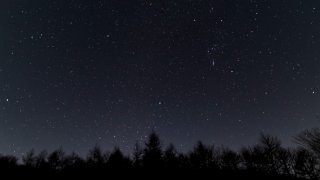
A stunning five-planet alignment will be visible in the sky for the month of June, making for a sight that hasn't be seen in nearly two decades.
According to the Adler Planetarium, "all of the planets visible to the naked eye — and some that aren’t visible —are in or near the same quadrant of the pre-dawn sky this month."
While planetary conjunctions aren't uncommon, the numbers of planets in this month's alignment is less common. But what makes this alignment even more special is the order in which the planets can be seen.
According to Sky and Telescope, the planets will line up in their natural order from the sun.
Feeling out of the loop? We'll catch you up on the Chicago news you need to know. Sign up for the weekly Chicago Catch-Up newsletter here.
"The last time the five naked-eye planets were strung across the horizon in sequence was in December 2004," the publication reports. "But this year, the gap between Mercury and Saturn is much shorter."
According to Adler, Saturn is the first planet to line up, rising in the east-southeast just after midnight (CT) through June 14 and just before midnight from June 15 through the end of the month.
Jupiter follows, rising due-east around 2:30 a.m. at the start of the month and by 1 a.m. as the month ends.
Local
Shortly after Jupiter comes Mars, which rises in the east and is about as bright as Saturn.
"All month long Mars remains below and to the left of Jupiter," Adler reports. "The two planets appear very close at the start of the month but move further apart in the sky each morning. They appear about 20 degrees apart by month’s end."
Venus, which will be the brightest planet in the alignment and, according to Adler, will be "unmistakably bright," rises east-northeast around 4 a.m.
The brightest planet, Venus, rises in the east-northeast about 4:00 am CT this month. At nearly minus-four magnitude, Venus is unmistakably bright.
While Mercury may be visible earlier in the month, the second half will likely offer better chances for viewing, Adler states.
"In the second half of the month, if you have a very clear view of the east-northeast horizon, try looking below and to the left of Venus about 40 minutes before sunrise. You may be able to spot the planet Mercury," the planetarium reports. "The planet won’t get very high in the sky—perhaps only five degrees—before the rising Sun blots Mercury from view. While you’re observing, do not look at the Sun, or you risk eye damage."
On top of that, the Moon moves near each planet in turn for the final two weeks of the month.
According to Adler, skywatchers will see a "waning gibbous moon" just below Saturn on June 18. By June 21, a "waning crescent moon" will be below Jupiter, moving to the right of Mars for June 22. On June 26, it will be to left of Venus and one day later it will be to the left of Mercury, though this may hard to see in the Chicago area.
While you may not be able to see them with an "unaided eye," Adler also reports Uranus and Neptune will be in the same quadrant with the five other planets. Nearby, will be Pluto and Eris.



